Our intrepid Singapore Sommelier, Shalom Chin, treks through the hills of Dogliani in Piedmont and discovers some serious Dolcetto.
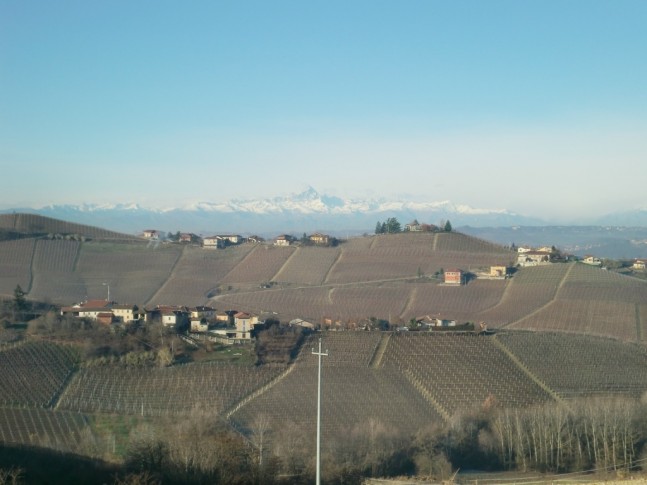
The endless rows of Docletto vines
Dolcetto is a wine that is widely drank in Piedmont, especially in the region of Alba. For those who know Italian, they would quickly assume that the wine is sweet as its name translates to “little sweet one”. Although the berries can be very sweet and are used to make a local jam, the wines are fermented dry. Its acid levels are not as high as Barbera but recent wines which I have tasted do contain a good amount of acid to go with a meal. The Italians love their acid and they also understand the grape well enough to know when to pick it.
Historically, Dolcetto is a wine that is used for bartering in exchange for meat, salt, olive oil and other produce. Today, it still remains a staple wine on Italian tables due to its affordability and is considered as an entry-level wine of Piedmont wineries.
| Type | Min. Alcohol | Aging | Notes |
| Dolcetto d’Alba DOC | 11.5% | Not required | 12% alcohol if vineyard name is mentioned |
| Dolcetto d’Alba “Superiore” DOC | 12.5% | 12 months aging from 1st Jan following the year of harvest. | |
| Dolcetto di Diano d’Alba or Diano d’Alba DOCG | 12% | Not required | |
| Diano d’Alba “Superiore” DOCG | 12.5% | 10 months aging | |
| Dogliani DOCG (previously Dolcetto di Dogliani DOC) | 12% | Not required | Merged with Dolcetto delle Langhe Monregalesi DOC |
| Dolcetto di Dogliani “Superiore” or Dogliani DOCG | 13% | 12 months aging | |
| Dolcetto d’Asti DOC | 11.5% | Not required | |
| Dolcetto d’Asti “ Superiore” DOC | 12.5% | 12 months aging from 1st Jan following the year of harvest. | |
| Langhe Dolcetto DOC | 11% | Not required |
Dolcetto is widely grown between altitudes of 200 to 700 metres in Piedmont. It planted mostly in sites where Nebbiolo would not do so well at higher altitudes. In contrast to Barbera, I find that Dolcetto grown towards the direction of Alba tends to taste structurely better than those in Asti . In Alba, it is more concentrated and has higher acidity than in Asti or Monferrato. There is also the small commune of Diano d’Alba within the Alba zone that is known for its Dolcetto. It is located about 500 metres above sea level. Dogliani, which has higher altitudes and is in the south of the Dolcetto d’Alba zone, produces more structure but is less fruity than those of Alba. The grape expresses itself the best on the calcareous soils of Dogliani.
As a wine, Dolcetto is characterised by its deep colour when young, and has a dominant cherry nose. The wine smells sweet, which imparts an impression of a sweet wine but does not taste so. The best examples are those that have their aromatics wafting out of the glass without much swirling and oak that gives the wine additional structure and flavour dimension. I noticed that my favourite Dolcetto wines are usually made from the ones fermented at around 26°C for a longer period of 8 days and are mainly from the more sunny south-facing slopes. The skins of Dolcetto contain a lot of anthocyanin (colour pigments) and tannins which is why most producers do not ferment the wine on skins for long periods. However, with good tannin management, the wine could benefit from extra body weight.
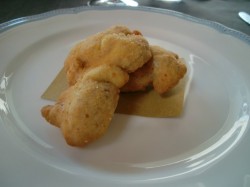
Fancy deep fried cow brain with Dolcetto
Usually the best exposition is the South. This is given to Dolcetto in Dogliani. In Langhe (Alba), the best exposition is usually set aside for Nebbiolo and in Monferrato (Asti), preference is given to Barbera. At the risk of losing the cherry aromas, it is recommended that the wine be consumed within 2 to 3 years. The more complex examples from Diano, Dogliani and some from Alba can age for 5 to 7 years. The wine is versatile with food and can complement a list of dishes such as: fresh spring rolls with sweet/sour sauce, white meat such as fish and pork, fried rice, rice dumplings, steamed fried beef with broccoli, tajarin, antipasto and even deep fried cow brain.
Just like Barbera, it suffers from reduction in the cellars and requires racking. Growing Dolcetto is also not an easy task and it needs more work in the vineyard than in the cellars. Although the vines are less vigorous than Barbera, the canes have a liking to grow wildly all over the place. It is prone to Oidium (powdery mildew) and Peronospora (downy mildew) because of the humidity in the region. It is also susceptible to Aphids which changes the leaf colour to yellow, affecting photosynthesis. The grape is the first to ripen in the region before Barbera and Nebbiolo.
Tasting Notes:
A note about my star system
The star system reflects my own preferences and is not meant to build a quality hierarchy. Rather, it is meant to highlight to busy readers who do not have the time for every tasting note by pointing out the wines that I love in particular. All wines that are in the write-up are delicious and drinkable wines. If they were not, I would not have taken the time to put them in.
No star = wines which I do not mind re-visiting again in the future to revise my opinion. If I were going to a party, I would still buy them to share or have it with meal.
*star = A wine that I would love to drink again tomorrow or next week because it is interesting. If I could, I may age a bottle out of curiosity, just so I can see if it is able to stand the test of time.
** star = A wine that I feel is complex, inviting, concentrated. It has a long length. I would drink it again tomorrow, the day after and in the future. I would love to age it out of curiosity or because I believe it will improve with time.
*** star = I would drink this every day for the next one year if I could afford it. It’s a drink-now and a keeper at the same time.
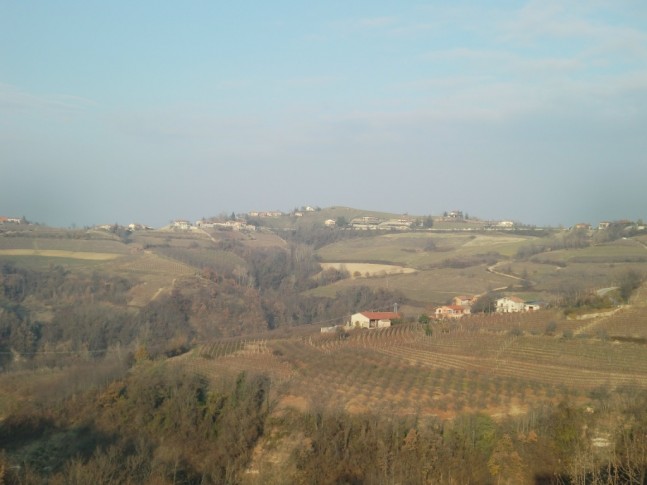
Alta Langhe Dolcetto at Anna Marie Abonna 570 m and during winter there is lots of snow
Anna Marie Abbona
Anna is the 4th generation of her family to reside in Piedmont. Although she is not a winemaker by training, she comes from a long line of winemaking tradition. 20 years ago, she decided to go back to her roots from the graphic design industry to produce quality wines. She and her husband, Franco own 11 hectares of land and are at the forefront of bringing out the best of what Dogliani has to offer. With some vineyards up to 570m, managing them is a challenge, partly due to snowy conditions. Coupled with her eagerness to experiment, she also makes wines from Nascetta and Riesling. She has Nebbiolo vines planted in Montforte.
There are about 70 producers in Dogliani and Anna is the vice-president of the Association. It was very clear that Anna is passionate about Dolcetto, in particularly Dogliani. “Dolcetto used to be the wine of Piedmont,” she says. “Old Dolcetto is easy and light-hearted but Dogliani is a serious wine. Each winery usually makes Barbera and Nebbiolo but Dolcetto is considered the most important. Our region has old vines which is our heritage. In the past, we had no money to re-plant vines as we were poor so we preserved the old vineyards. Old vines make complex and rich grapes. Dogliani has potential for the future.”
Her style is entirely refreshing and offers a different perspective on what Dolcetto is able to achieve. She has somehow managed to capture the aromatics of each grape variety she handles, even the Nebbiolo. Her wines are bursting with aromas and need little coaxing to bring out the nose. This also reflects her character – as someone who needs little coaxing to share her thoughts. She shared a story about how as a kid growing up in a farm and being far from “civilization”, she felt constantly bored with the lack of company. She would learn other languages so that she could actively communicate with others around her. At her winery, I witnessed her speaking Italian, English and German as she hosted different nationalities.
Anna does not machine filter her wines except the whites if it is required. She usually ferments her whites at around 12-13 °C to capture the aromatics. Indigenous yeast is used if the vintage is perfect. She never uses new barrels for Dolcetto as Dolcetto is delicate and hard to capture the aromatics. Instead, she uses 3rd and 4th year old barrels.
Anna Marie also makes a Langhe Nebbiolo, Nascetta, Riesling and other grape varieties.
“Sori Dij But”, Dolcetto di Dogliani, 2010, 13%, €8
Deep purple colour. Cherry nose, spicy, med(+) intensity, light pepper spice. The palate is med(+) acid and tannins, slightly grainy, cherry finish, long length, so juicy.
No oak and only stainless steel. 40-45 year old vines. Grapes are taken from East, south, west exposures at 500-530 m on calcareous marl .Yields of 0-75 hl/ha.
**“Maioli”, Dogliani DOCG, 2009, 14.5%, €10
Deep purple colour. Light cherry nose, denser than the last wine, med(+) intensity, complex and lifted. The palate is med(+) acid, confectionary, very long length, juicy and so packed on flavours, med tannins, and smooth.
1.5 ha vineyard that has been planted since 1936. Chalky soil at 500 m and yields of 50hl/ha. Stainless steel ferment for 8-10 days and aged 14 months in steel. Ferments at 23-26°C for one week. Remontage for 3 times a day. 6000 vines /ha at S-E slopes. 50-100 vines are replaced every 5 years as they are dying and have no leaves.
*“San Bernado”, Dogliani DOCG, 2007, 14.5%, €13
Deep ruby colour. Light morello cherries nose, smoke, balanced aromas, leather, lifted, light chocolate, light cherry and liquorice. The palate is med(+) tannins, slightly chewy and rough, chocolate, cherry, long length, soft and subtle finish with elegance.
The 2009 is bottled only in 2012 September. Aged in 25hl botte. The vineyard is 550 m, SE and east-facing and the distance between the rows is wide because they would plant grains between the rows. The vines here are planted since 1943. The grapes are given more time to ripen. They have more acid and tannins. Yields are controlled to give the grapes higher potential alcohol. The vines are at 550 m and fermenting in steel for 10-12 days. Aging takes place in 25 hl old barrels for 18 months.
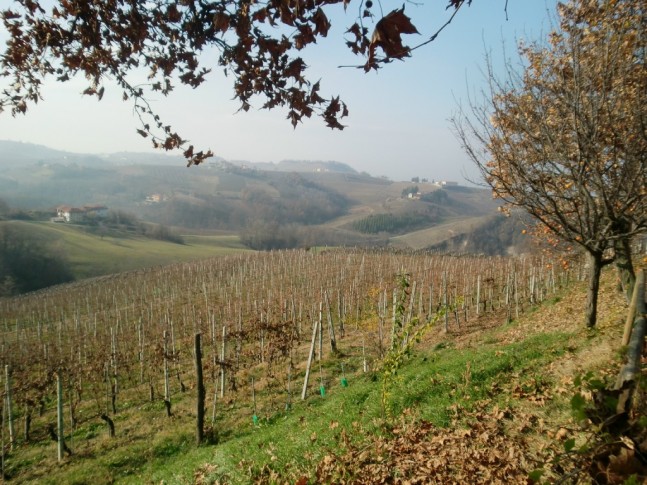
Dogliani at Osvaldo Barberis
Osvaldo Barberis
Osvaldo Barberis are a small family-producer based in Dogliani. They use no sulphur on their vineyards and believe in sustainable farming. To Osvaldo, Dolcetto is a difficult and challenging wine to make. There is a need to balanced fruit and the benefits of barrel flavour and preserve the delicateness of Dolcetto. Osvaldo uses medium toast Taurasand, Boutes and Vicard oak.
The Estate own 9 hectares of grapevines. Out of the 9 hectares, seven hectares go to Dolcetto, one to Nebbiolo d’Alba and one to Barbera d’Alba. The wines are unfiltered.
“Valdiba”, Dogliani DOCG, 2010, 13.5%, €5
Med(+) purple colour. Red cherry nose, fruity, liquorice, light spice, lead, mint, med(+) intensity. The palate is high acid and alcohol, med(+) tannins, long length with light herbs.
17 000 bottles produced.
“Puncin”, Dogliani DOCG, 2010, 14%, €6
Deep purple colour. Cherry nose, ash tray, spicy herbs and lead. The palate is med(+) acid, and tannins, dry tannins, carpet texture, cherry, med(+) length
Vinification in steel for 8 days and no oak.
“Avrì”, Dolcetto di Dogliani DOC, 2010, 14%
Deep purple colour. Nose of dates, lead, med(+) intensity. The palate is med(+) tannins, prunes, dates, light cherry flavours in the mid-palate, med(+) acid, high alcohol, long length, drying tannins in the back on the tongue.
No oak and sulphur.
Chionetti
“Briccolero”, Dolcetto di Dogliani DOC, 2010, 14%
Deep purple colour. Light cherry aromas, med(+) intensity, beautiful crystallised fruit on the nose. Med(+) tannins, light rubber texture, lots of cherries in the mid- palate, long length, med(+) acid, high alcohol.
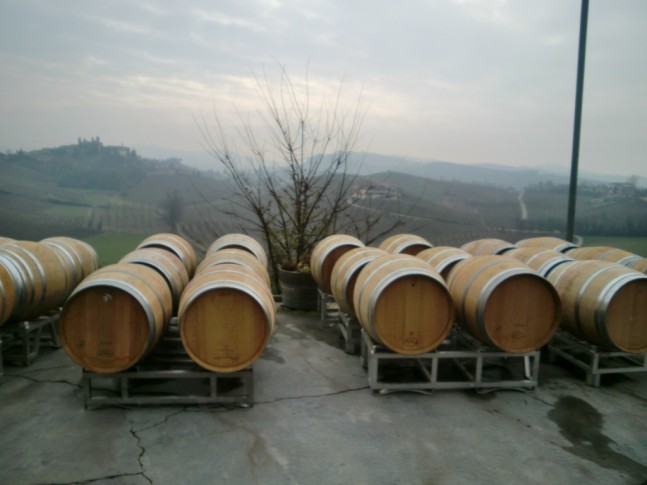
Racking to take place at Fontanbianca
Fontanabianca
Dolcetto d’Alba, 2010, 12.5%
Med(+) purple colour. Good cherry aromas, sweet and spicy, light cedar oak, freshly bottled aroma, light pepper spice. The palate is med(+) acid, light cedar oak, slight charcoal, freshly bottled, soft tannins, light cherry, med length, slight cedar lead flavours with some herbs.
Grapes are from Neive at an East facing vineyard. This usually sees 3 years of aging before drink now.
Pelissero Pasquale
“Crosa”, Dolcetto d’Alba, 2010, 13%, €4.50
Med(+) purple colour. Cherry nose, black tea, med(+) intensity, light spice, pepper, slight oak, raw smell. On the palate is high acid, med(+) tannins, tannins that sucks on the gum, mouth plucking, cherry , rawness, med(+) length, lots of acid in the back palate.
Stainless steel ferment only.
E.Pira e Fìgli, Chiara Boschis
**Dolcetto d’Alba, 2010, 13%, €8
Deep purple colour. Fresh nose, newly bottled, light cherry fruit, slightly fragrant, lifted black pepper spice, med(+) intensity, elegant. The palate is medium intensity of flavours, gentle and soft, med(+) acid and med alcohol and tannins, lightly grainy, sour cherries, very good quality, nice concentration, a young wine but impressive nose, long length, beautiful finish.
Fermented for 8 days. The grapes are from the Montforte area under clay soils. The vineyards are Raveru and Mosconi. It is simple and balanced on the palate but complex on the nose. Good with cold appetisers.
Ettore Germano
*“Pradone”, Dolcetto d’Alba, 2010, 13.5%, €9
Med(+) purple colour. Nose of cherry, confectionary, med(+) intensity. The palate is med(+) acid, medium alcohol, beautiful fruits and raspberry sweetness, long length, sweet cherries and good fruit.
Ferment at 25°C, Pumping over 2 times a day and 5 days of skin contact. Finish the ferment without skins. 8000 bottles. The vineyard is South-West at 340-370m.
Mustela
**Dolcetto d’Alba, 2010, 13%, €5
Med(+) purple colour. Fruity and sweet cherry nose, lifted, spicy sweetness, confectionary, light peppermint. The palate Is med(+) acid, lots of fruit flavours, med alcohol, lots of light spice, medium length, sweet cherry finish. This is a beautiful Dolcetto. One of the best I have had and very well-priced.
The soils are schist and marl at 370m with a southern exposition. The grapes are de-stemmed and fermented for 5-6 days at 26-27°C, racked twice in a week as it is easy to have reductive smells.
La Ganghija
**Dolcetto d’Alba DOC, 2010, 13.5%
Deep purple colour. A very fruity nose, raspberry, like Grenache, confectionary, light leafy spice, so fruity, med(+) intensity, lifted like bon bons and sweet cherry. The palate is med(+) alcohol, ripe, medium acid, dry but sweet fruit, medium tannins, juicy, soft, very fruity with cracked black pepper, long length, cracked black pepper finish, unbelievable power like a black pepper crab.
From Triezo. Harvested slightly early as the vineyard is sunny and grapes arrive earlier. After ferment in steel for 10 days at 26-28°C, MLF is done in tank and bottled in spring. The grapes were de-stemmed and pump over was 3 times a day. The pumping over was reduced at the end of ferment. Packet yeast was used.
|
|
Tweet |






No comments to Dolcetto in Piedmont – Not a Sweet Wine | Comments Feed
No comments yet
The comments are closed.